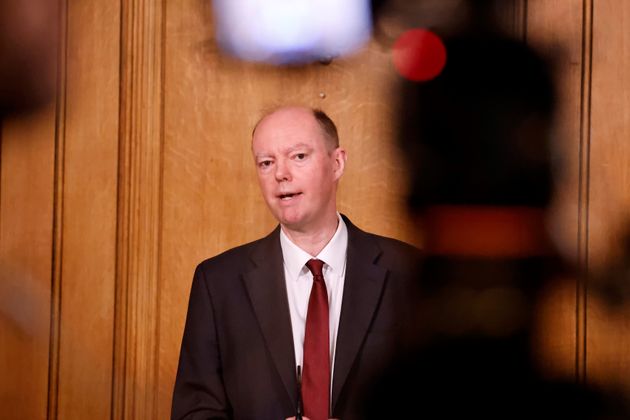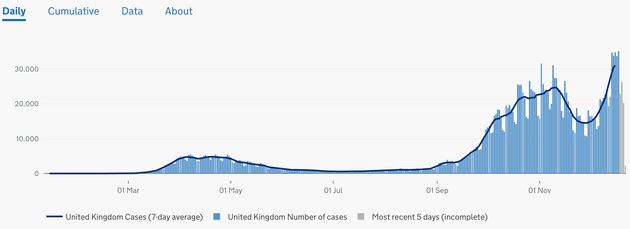Remember when science came without a “the”?
Britain became a nation of amateur epidemiologists in 2020, wielding words and phrases like “R-rate”, “doubling time”, “phase 3 clinical trials” and “acute respiratory infection incident” (well, OK, maybe not) with ease.
But one of the strangest changes to the English lexicon during the coronavirus pandemic has been the addition of the definite article to the otherwise quite normal word “science”.
The government has been desperate to show that its at times unpopular decision making is guided by the advice of experts. Google results suggest the expressions “guided by the science” and “follow the science” have appeared on national and local government websites hundreds of times this year, compared with just seven in all previous years combined. And the phrases were used repeatedly by health secretary Matt Hancock and prime minister Boris Johnson at press conferences and in the Commons.

Except quite often key observations and recommendations made by scientists – chiefly, the government’s own Scientific Advisory Group for Emergencies (Sage) – don’t appear to have translated into ministerial action at all, sometimes with devastating consequences.
Here are a few of the times when the government seemingly wasn’t “guided by the science”.
The Christmas relaxations
Sage recommended: Cutting the newly announced three-household “Christmas bubbling” rule (on which more in a moment) from five days to one or two at its meeting on December 2.
The government: Spent two weeks not acting, said it would be “inhuman” to change people’s Christmas plans, then with just three days to spare cancelled the relaxation altogether for parts of the country on December 19 – and reduced it everywhere else from five days to one.
Bedroom tax and the benefit cap
Sage recommended: Scrapping the bedroom tax, and the “no recourse to public funds” (NRPF) and benefit cap rules that limited the amount of government help people could access. They said at their meeting on November 24 that these factors could make it harder for people to self-isolate by reducing the amount of space available for them to stay away from others, and forcing them to work even while sick so they could afford to live.
The government: Didn’t. The Department for Work and Pensions defended the bedroom tax as “an important tool to help to manage housing support expenditure and enable mobility within the social rented sector” and pointed to billions of pounds it had spent on welfare this year more generally.
The word ‘bubbles’
Sage recommended: Find a better word than “bubbles”. Specifically, on November 24, it said the rules around household mixing should be “communicated in a meaningful way so that it is clear how it applies. […] For example, the term ‘bubbles’ does not translate easily into non-English languages so alternative terms should be identified which will resonate”.
The government: Continued to refer to bubbles (for instance, here).
Helping children self-isolate
Sage recommended: Give young Covid sufferers free Netflix and data to help them stick to the rules and self-isolate. This advice was given on October 22.
The government: Hasn’t done this.
Circuit-breaker
Sage recommended: Imposing a two-week circuit breaker lockdown to control rising infections. This advice was given on September 21.
The government: Resisted calls for a circuit breaker, instead introducing a tiered lockdown system and, subsequently, a second national lockdown – but not until early November, by which time infections had grown substantially:

Online teaching at universities
Sage recommended: Moving all university teaching online unless “absolutely essential” on September 21.
The government: Didn’t instruct universities to move all non-essential teaching online. Infection rates at universities soared and students’ mental as well as physical health suffered.
Opening of businesses
Sage recommended: Shutting bars, restaurants, cafes, gyms and hairdressers on September 21.
The government: Kept them all open unless they were in local lockdown. It didn’t shut the rest, as Sage wanted, until the second UK lockdown six weeks later.
Household mixing
Sage recommended: Banning all household mixing indoors, again on September 21.
The government: Continued to allow household mixing (except where there were local lockdowns in place) until the second national lockdown in November.
Risk to students

Sage warned: There would be a “significant” risk of infection, including asymptomatic spread, if students returned to campus. This is taken from a meeting on September 3.
The government: Sent students back to campus. Thousands caught the virus. There was also some limited evidence that areas with the most students suffered higher levels of Covid than other places in the country.
Protecting Black and Asian groups
Sage recommended: Given that Black, Asian and minority ethnic groups have been among the hardest hit by the virus (see here, here and here, for instance), the risk to them should be “mitigated by policy makers”. Sage also told the government on June 4 that it was important to involve BAME groups in “framing research questions, participating in research projects, sharing findings and implementing recommendations”.
The government: Failed to stop BAME groups being among the worst affected in the second wave, and continued to host overwhelmingly white press conferences about Covid that may have contributed to a lack of trust in government advice among some communities. It also didn’t prioritise BAME people for the vaccine.
Reopening schools
Sage and chief scientific adviser Patrick Vallance recommended: Don’t reopen schools from June 1 without an effective test and trace system.
The government: Reopened schools for some students before the summer holidays even though Test and Trace didn’t begin regularly hitting its 80% target for reaching close contacts until December.